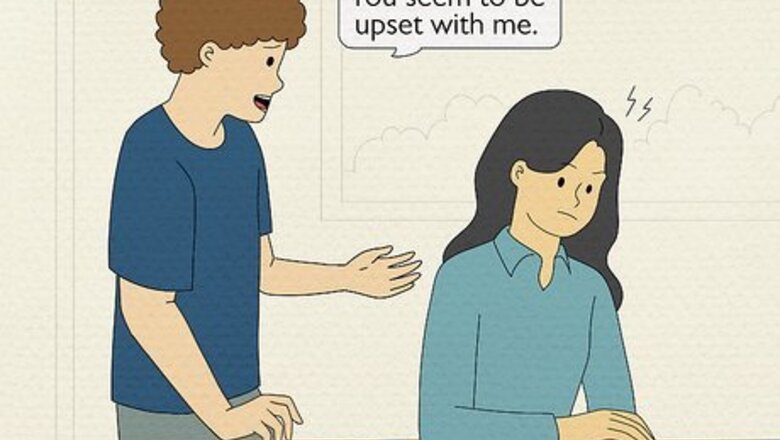
views
X
Research source
A good apology will communicate three things: regret, responsibility, and remedy. Apologizing for a mistake might seem difficult, but it will help you repair and improve your relationships with others.
Preparing Your Apology
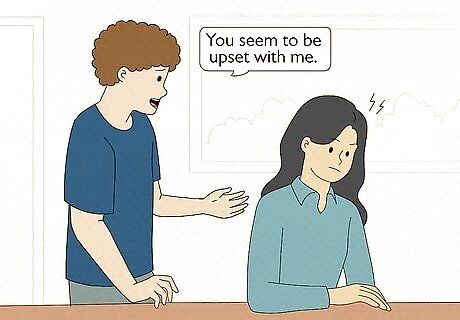
Own your mistake. Words aren’t enough. You need to understand what you’re apologizing for and really mean your words. Expressing regret and guilt is the key to a genuine apology, but how would you do so if you don’t know what you’re apologizing for? Spend some time over-reflecting how your words or actions would’ve hurt the other person. Once you’ve realized your mistake, take responsibility for your actions. Do not try to be defensive or give excuses. Sincerely apologize and explain your intentions, not justify your behavior. In case you are not aware of what you did wrong, simply ask the person in a friendly manner. Instead of: “Why are you mad now?” Try this: “You seem to be upset with me. Did I do something to cause that?”
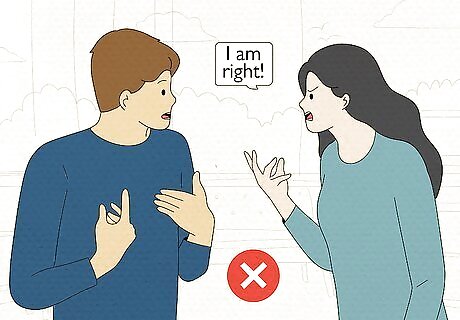
Give up the idea of being “right.” Arguing about the details of an experience that involves more than one person is usually frustrating because the experience is highly subjective. How we experience and interpret situations is unique to us, and two people may experience the same situation very differently. An apology needs to acknowledge the truth of the other person’s feelings, regardless of whether you think they’re “right” or not. For example, imagine that you went out to the movies without your partner. Your partner felt left out and hurt. Instead of arguing about whether they are “right” to feel this way or whether you were “right” to go out, acknowledge that they felt hurt in your apology.

Use “I”-statements. One of the most common mistakes of apologizing is using “you” instead of “I” statements. When you apologize, you must accept responsibility for your actions. Don’t push responsibility for the offense off on to the other person. Keep the focus on what you did, and avoid sounding like you’re blaming the other person. For example, a very common but ineffective way of apologizing is to say something like, “I’m sorry your feelings were hurt” or “I’m sorry you got so upset.” An apology does not need to apologize for the other person’s feelings. It needs to acknowledge your responsibility. These types of statements don’t -- they push the responsibility back onto the person who was hurt. Instead, keep the focus on you. “I’m sorry I hurt your feelings” or “I’m sorry that my actions upset you” express responsibility for the hurt you caused, and don’t come across as blaming the other person. This can be challenging when we put our defensive caps on - “I wouldn’t have done it if you….” Blaming often takes away the part of owning the mistake.
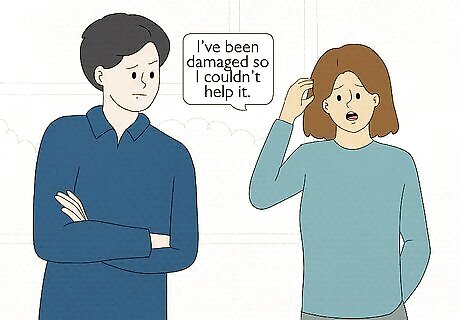
Avoid justifying your actions. It’s natural to want to justify your actions when explaining them to another person. However, presenting justifications will often negate the meaning of an apology, because the other person may perceive the apology as insincere. Justifications may include claims that the person you hurt misunderstood you, such as “you took it the wrong way.” They may also include denial of injury, such as “it wasn’t really that bad,” or a sad tale, such as “I’ve been damaged so I couldn’t help it.”
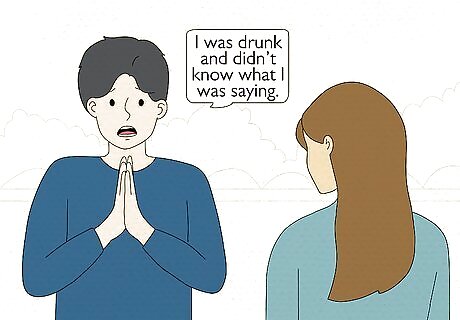
Use excuses cautiously. An apology may express that your offense was not intentional or aimed at harming the person. This can be helpful in reassuring the person that you care about them and did not mean to cause harm. However, you must be careful that your reasons for your behavior don’t slip into justifying away the harm you did. Examples of excuses might include denying your intent, such as “I didn’t mean to hurt you” or “It was an accident.” Excuses may also include denial of volition, such as “I was drunk and didn’t know what I was saying.” Use these types of statements carefully, and make sure that you always acknowledge the hurt you did first before following it with any reasons for your behavior. The person who was hurt is more likely to forgive you if you offer excuses rather than justifications. They are even more likely to forgive you if you offer excuses in combination with accepting responsibility, acknowledging the hurt, recognizing the proper behavior, and ensuring proper behavior in the future.
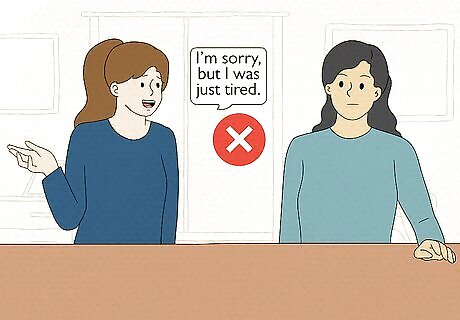
Avoid the “but.” An apology that includes the word “but” will almost never be understood as an apology. This is because “but” is what’s known as a “verbal eraser.” it shifts the focus from what should be the point of the apology -- acknowledging responsibility and expressing regret -- to justifying yourself. When people hear the word “but,” they tend to stop listening. All they hear from that point is “but this was really all your fault.” For example, don’t say something like, “I’m sorry, but I was just tired.” This emphasizes your excuse for the offense, rather than focusing on your regret for hurting the other person. Instead, say something like, “I’m sorry I snapped at you. I know that hurt your feelings. I was tired, and I said something I regret..”
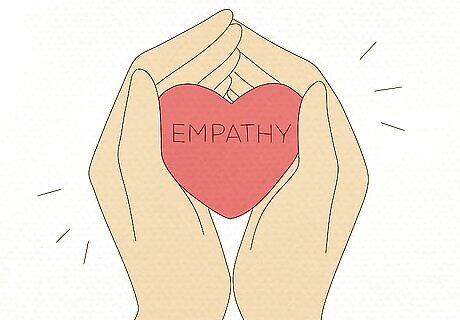
Consider the other person’s needs and personality. Studies suggest that “self-construal” affects how the other person accepts your apology. In other words, the way the other person sees him- or herself in relation to you and to others affects what type of apology will be most effective. For example, some people are highly independent and value things such as entitlements and rights. These people are more likely to be receptive to an apology that offers a specific remedy for a hurt. For people who highly value their close personal relationships with others, they may be more likely to be receptive to an apology that expresses empathy and regret. Some people highly value social rules and norms and imagine themselves as part of a larger social group. People like this may be most likely to be receptive to an apology that acknowledges that values or rules were violated. If you don’t know the person very well, aim to incorporate a little bit of everything. These apologies are more likely to acknowledge what is most important to the person you’re apologizing to.
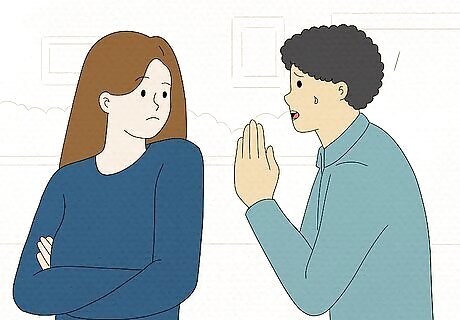
Ask for forgiveness. When you ask for forgiveness, it shows that you’re allowing the other person to react and respond. It shows that you’re not automatically assuming that it's all forgiven and forgotten. Remember, forgiveness isn’t guaranteed no matter how true the apology is. It is to be earned by regaining trust and apologizing in a healthy way is a big start!

Show empathy. Try to understand how your actions hurt them and accept your mistake, even if you did not do it. For example: I know I hurt you, or I understand how upsetting that would’ve been. Also remember, that apologizing isn’t an instant fix. It is just the first stage. Be open to feedback and be mindful of those actions from time after.

Write your apology down, if you like. If you're having a hard time mustering the words for an apology, consider writing your feelings down. This will help you make sure that you express the wording and feelings just right. Take your time and sort out exactly why you feel compelled to apologize, and what you'll do to ensure the mistake won't happen again. If you worry that you will become very emotional, you can bring your notes with you. The other person may even appreciate that you took such care to prepare the apology. If you’re concerned you will mess up your apology, consider working it through with a close friend. You don’t want to practice so much that your apology seems forced or over-rehearsed. However, it may be helpful for you to practice your apology with someone and get their feedback about it.
Apologizing at the Right Time and Place

Find the right time. Even if you immediately regret something, an apology may not be effective if it comes in the middle of a highly emotional situation. For example, if you are still in the middle of an argument, your apology may not be effective. This is because it is very hard to meaningfully listen to others when we’re overcome with negative emotions. Wait until you have both cooled off before making your apology. Additionally, if you apologize while your emotions are rushing, you may have trouble conveying sincerity. Waiting until you have collected yourself will help you say what you mean to say and make sure that your apology is meaningful and complete. Just don’t wait too long. Waiting days or weeks to apologize can do damage too. In professional settings, it’s a good idea to make your apology as soon after the mistake as possible. This will help avoid interrupting the flow of work in your workplace.

Do it in person. It’s much easier to convey sincerity when you make your apology in person. Much of our communication is nonverbal, through things such as body language, facial expressions, and gestures. Whenever possible, apologize in person. When you apologize in person, your gestures and expressions help reveal how much you regret and how truly sorry you are. Apologizing via text might add on to further unnecessary misunderstandings. If apologizing in person isn't an option, use the telephone. The tone of your voice will help communicate that you're sincere.

Choose a quiet or private setting for the apology. Apologizing is often a very personal act. Finding a quiet, private place to apologize will help you focus on the other person and avoid distractions. Choose a space that feels relaxing, and make sure you have enough time to not feel rushed.

Make sure you have enough time to have a complete conversation. Rushed apologies are often ineffective. This is because an apology must perform several tasks. You must fully acknowledge your offense, explain what happened, express your regret, and show that you will do differently in the future. You should also choose a time when you will not feel rushed or stressed. If you’re thinking about everything else you still have to do, your focus will not be on the apology, and the other person will feel that distance.

Be ready to apologize multiple times, but don’t overdo it. There is no one way to apologize. You may have to try multiple times in different ways to apologize, depending on your relationship and how they’ve been hurt. However, this does not mean that you go on apologizing forever or make grand gestures that make it embarrassing for them. Remember, the apology is for them, not you. You can’t force someone’s forgiveness. If they’re firm they do not want to engage any further, move on.
Making Your Apology

Be open and non-threatening. This type of communication is called “integrative communication” and involves discussing issues openly and in a non-threatening way to reach mutual understanding, or “integration.” Integrative techniques have been shown to have long-term positive effects on relationships. For example, if the person you hurt tries to bring up a pattern of past behavior that they believe is related to your mistake, allow him/her to finish. Pause before you respond. Consider the person’s statements, and try to see the situation from the other person’s perspective, even if you disagree. Don’t lash out, yell, or insult the other person.

Use open, humble body language. The nonverbal communication you give while apologizing is just as important as what you say, if not more so. Avoid hunching or slouching, as this could indicate that you are closed to the conversation. Make eye contact while speaking and listening. Aim for at least 50% of the time while you are speaking, and at least 70% of the time while you are listening. Avoid crossing your arms. This is a sign that you feel defensive and are closed to the other person. Try to keep your face relaxed. You don’t have to force a smile, but if you feel a sour expression or grimace on your face, take a moment to relax those muscles. Use open palms rather than closed hands if you want to gesture. If the person is close to you and it’s appropriate, use touch to convey your emotions. A hug, or a gentle touch on the arm or hand, can communicate how much the other person means to you.
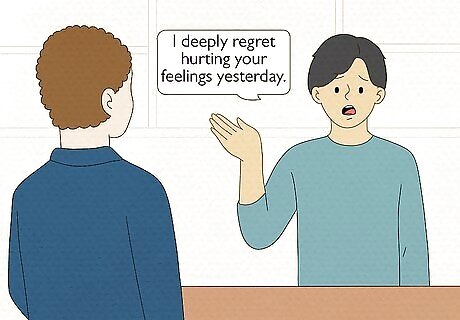
State your regret. Express your empathy toward the other person. Acknowledge the hurt or damage that you did. Acknowledge the other person’s feelings as real and valued. Studies have shown that when apologies appear to be motivated by feelings of guilt or shame, they are more likely to be accepted by the hurt person. In contrast, apologies motivated by pity are less likely to be accepted, because they seem less sincere. For example, you could begin an apology by saying “I deeply regret hurting your feelings yesterday. I feel terrible about causing you pain.”
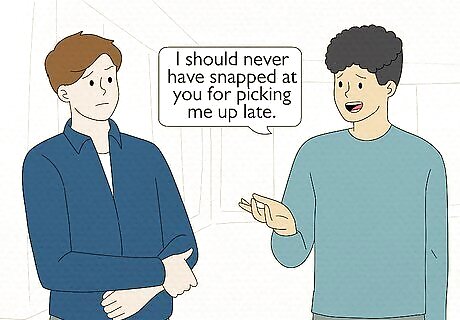
Accept responsibility. Be as specific as possible when you accept responsibility. Specific apologies are more likely to be meaningful to the other person, because they show that you have paid attention to the situation that hurt him/her. Try to avoid overgeneralizing. Saying something like “I’m a terrible person” is not true, and it isn’t attentive to the specific behavior or situation that caused the hurt. Overgeneralizing makes addressing the issue seem impossible; you can’t fix being a “terrible person” as easily as you can fix “not paying attention to someone else’s needs.” For example, continue the apology by stating what, specifically, caused the hurt. “I deeply regret hurting your feelings yesterday. I feel terrible about causing you pain. I should never have snapped at you for picking me up late.”

State how you will remedy the situation. Apologies are likely to be most successful if you offer a suggestion about how you will do things differently in the future, or repair the hurt in some way. Find the underlying problem, describe it to the person without pointing fingers at anyone else, and tell him or her what you intend to do to solve that problem so that you can avoid the mistake in the future. For example, “I deeply regret hurting your feelings yesterday. I feel terrible about causing you pain. I should never have snapped at you for picking me up late. In the future, I will stop to think more carefully before I say things.”
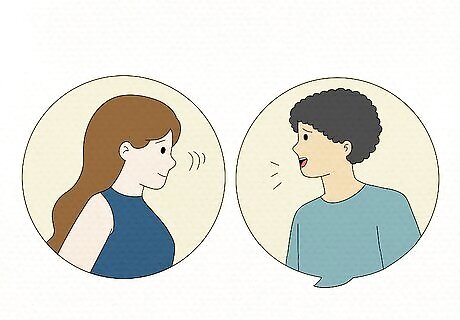
Listen to the other person. The other person may want to express their feelings to you. S/he may still be upset. They may have more questions for you. Do your best to stay calm and open. If the other person is still upset with you, s/he may react in an unfavorable way. If the person yells or insults you, these negative feelings may prevent forgiveness from occurring. Either take a timeout or try to redirect the conversation to a more productive topic. To take a timeout, express your empathy for the other person and offer them the choice. Try to avoid seeming like you’re blaming the other person. For example, “I clearly hurt you, and it seems like you’re upset right now. Would it be helpful to take a brief timeout? I want to understand where you are coming from, but I want you to feel comfortable.” To redirect the conversation from negativity, try to learn specific behaviors that the other person wishes you had done instead of what you actually did. For example, if the other person says something like “You just never respect me!” you could respond by asking “What would help you feel that respect in the future?” or “What do you hope I would do differently next time?”
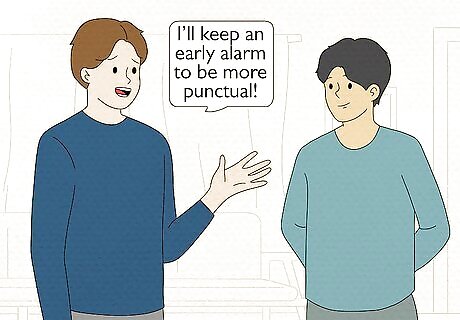
Tell them how you’ll change. Let them know how you’ll change and what you’d do to make that possible. For instance, if you’ve been late once again, instead of just apologizing, share how you’d keep an early alarm to be more punctual! A true apology is one where you acknowledge your mistakes and assure that it won’t be repeated again.
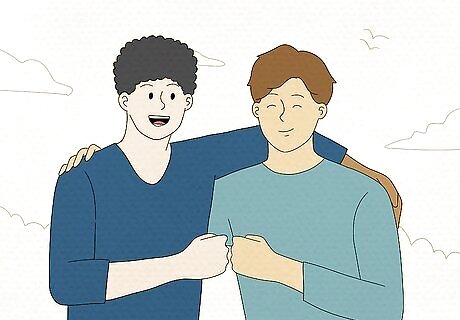
End with gratitude. Express your appreciation for the role that they play in your life, emphasizing that you do not want to jeopardize or damage the relationship. This is the time to briefly recount what has created and sustained the bond over time and tell loved ones that they are indeed loved. Describe what your life would be missing without their trust and their company.
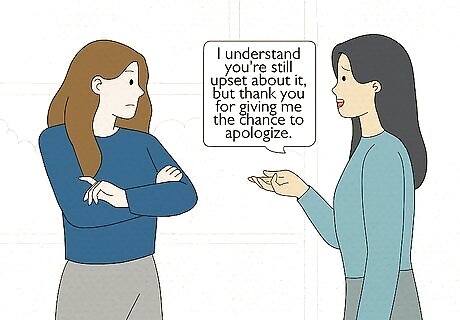
Be patient. If an apology is not accepted, thank the other person for hearing you out and leave the door open in case they want to talk about it later. For example, "I understand you're still upset about it, but thank you for giving me the chance to apologize. If you ever change your mind, please give me a call." Sometimes people want to forgive you, but they still need a little time to cool off. Remember, just because someone accepts your apology doesn't mean they've fully forgiven you. It can take time, maybe a long time, before the other person can completely let go and fully trust you again. There is little you can do to speed this process up, but there are endless ways to bog it down. If the person is truly important to you, it's worth it to give them the time and space they need to heal. Don't expect them to go right back to acting normally immediately.
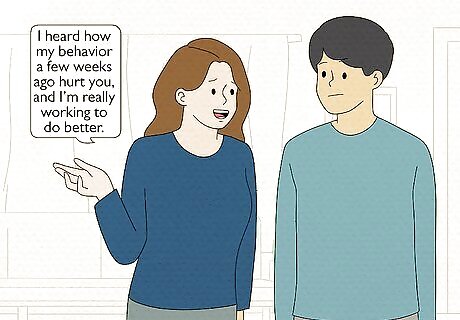
Stick to your word. A true apology includes a solution, or expresses that you are willing to fix the problem. You promised to work towards solving the problem, and you have to carry out your promise in order for the apology to be sincere and complete. Otherwise, your apologies will lose their meaning, and trust may disappear beyond the point of no return. Check in with the other person occasionally. For example, after a few weeks or so have gone by, you could ask “I heard how my behavior a few weeks ago hurt you, and I’m really working to do better. How am I doing?”


















Comments
0 comment